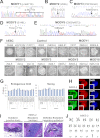Derivation of human induced pluripotent stem cells from patients with maturity onset diabetes of the young
- PMID: 23306198
- PMCID: PMC3581399
- DOI: 10.1074/jbc.C112.428979
Derivation of human induced pluripotent stem cells from patients with maturity onset diabetes of the young
Abstract
Maturity onset diabetes of the young (MODY) is an autosomal dominant disease. Despite extensive research, the mechanism by which a mutant MODY gene results in monogenic diabetes is not yet clear due to the inaccessibility of patient samples. Induced pluripotency and directed differentiation toward the pancreatic lineage are now viable and attractive methods to uncover the molecular mechanisms underlying MODY. Here we report, for the first time, the derivation of human induced pluripotent stem cells (hiPSCs) from patients with five types of MODY: MODY1 (HNF4A), MODY2 (GCK), MODY3 (HNF1A), MODY5 (HNF1B), and MODY8 (CEL) with a polycistronic lentiviral vector expressing a Cre-excisable human "stem cell cassette" containing the four reprogramming factors OCT4, KLF4, SOX2, and CMYC. These MODY-hiPSCs morphologically resemble human pluripotent stem cells (hPSCs), express pluripotency markers OCT4, SOX2, NANOG, SSEA-4, and TRA-1-60, give rise to derivatives of the three germ layers in a teratoma assay, and are karyotypically normal. Overall, our MODY-hiPSCs serve as invaluable tools to dissect the role of MODY genes in the development of pancreas and islet cells and to evaluate their significance in regulating beta cell function. This knowledge will aid future attempts aimed at deriving functional mature beta cells from hPSCs.
Figures


References
-
- Steck A. K., Winter W. E. (2011) Review on monogenic diabetes. Curr. Opin. Endocrinol. Diabetes Obes. 18, 252–258 - PubMed
-
- Takahashi K., Tanabe K., Ohnuki M., Narita M., Ichisaka T., Tomoda K., Yamanaka S. (2007) Induction of pluripotent stem cells from adult human fibroblasts by defined factors. Cell 131, 861–872 - PubMed
-
- Park I. H., Zhao R., West J. A., Yabuuchi A., Huo H., Ince T. A., Lerou P. H., Lensch M. W., Daley G. Q. (2008) Reprogramming of human somatic cells to pluripotency with defined factors. Nature 451, 141–146 - PubMed
-
- Kroon E., Martinson L. A., Kadoya K., Bang A. G., Kelly O. G., Eliazer S., Young H., Richardson M., Smart N. G., Cunningham J., Agulnick A. D., D'Amour K. A., Carpenter M. K., Baetge E. E. (2008) Pancreatic endoderm derived from human embryonic stem cells generates glucose-responsive insulin-secreting cells in vivo. Nat. Biotechnol. 26, 443–452 - PubMed
Publication types
MeSH terms
Substances
Grants and funding
LinkOut - more resources
Full Text Sources
Other Literature Sources
Medical
Molecular Biology Databases
Research Materials
Miscellaneous

